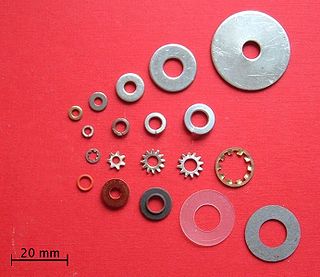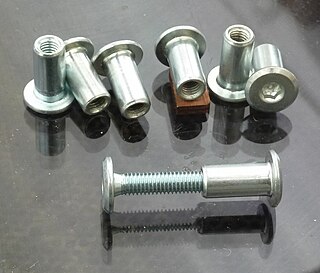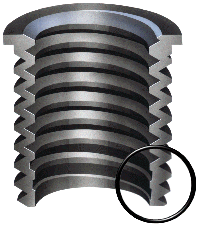Related Research Articles

A rivet is a permanent mechanical fastener. Before being installed, a rivet consists of a smooth cylindrical shaft with a head on one end. The end opposite to the head is called the tail. On installation, the rivet is placed in a punched or drilled hole, and the tail is upset, or bucked, so that it expands to about 1.5 times the original shaft diameter, holding the rivet in place. In other words, the pounding or pulling creates a new "head" on the tail end by smashing the "tail" material flatter, resulting in a rivet that is roughly a dumbbell shape. To distinguish between the two ends of the rivet, the original head is called the factory head and the deformed end is called the shop head or buck-tail.

A fastener or fastening is a hardware device that mechanically joins or affixes two or more objects together. In general, fasteners are used to create non-permanent joints; that is, joints that can be removed or dismantled without damaging the joining components. Welding is an example of creating permanent joints. Steel fasteners are usually made of stainless steel, carbon steel, or alloy steel.

A washer is a thin plate with a hole that is normally used to distribute the load of a threaded fastener, such as a bolt or nut. Other uses are as a spacer, spring, wear pad, preload indicating device, locking device, and to reduce vibration.

A bolted joint is one of the most common elements in construction and machine design. It consist of a male threaded fastener that captures and joins other parts, secured with a matching female screw thread. There are two main types of bolted joint designs: tension joints and shear joints.

A screw thread, often shortened to thread, is a helical structure used to convert between rotational and linear movement or force. A screw thread is a ridge wrapped around a cylinder or cone in the form of a helix, with the former being called a straight thread and the latter called a tapered thread. A screw thread is the essential feature of the screw as a simple machine and also as a threaded fastener.

A sex bolt is a type of mating fastener (nut) that has a barrel-shaped flange and protruding boss that is internally threaded. The bolts sits within the components being fastened, the flange provides the bearing surface. The sex bolt and accompanying machine screw sit flush on either side of the surfaces being fastened.

A locknut, also known as a lock nut, locking nut, self-locking nut, prevailing torque nut, stiff nut or elastic stop nut, is a nut that resists loosening under vibrations and torque. Prevailing torque nuts have some portion of the nut that deforms elastically to provide a locking action. Free-spinning locknuts exist which carry the advantage of not requiring extra torque until seated.

A nyloc nut, also referred to as a nylon-insert lock nut, polymer-insert lock nut, or elastic stop nut, is a kind of locknut with a nylon collar that increases friction on the screw thread.

A threaded insert, also known as a threaded bushing, is a fastener element that is inserted into an object to add a threaded hole. They may be used to repair a stripped threaded hole, provide a durable threaded hole in a soft material, place a thread on a material too thin to accept it, mold or cast threads into a work piece thereby eliminating a machining operation, or simplify changeover from unified to metric threads or vice versa.
A retaining ring is a fastener that holds components or assemblies onto a shaft or in a housing/bore when installed - typically in a groove - for one time use only. Once installed, the exposed portion acts as a shoulder which retains the specific component or assembly. Circlips are a type of retaining ring.
A split beam nut, also known as a split hex nut or slotted beam nut, is a locknut with slots cut in the top that separate the outside end into two or more sections that are bent slightly inward, making the thread diameter undersized in the slotted portion. As the nut is threaded on, these sections are forced back out to their original position and increase the friction between the nut and the fastener, creating the locking action.
A distorted thread locknut, is a type of locknut that uses a deformed section of thread to keep the nut from loosening from vibrations or rotation of the clamped item. They are broken down into four types: elliptical offset nuts, centerlock nuts, toplock nuts and partially depitched (Philidas) nuts.

A speed nut, aka sheet metal nut or Tinnerman nut, is a type of locknut with two sheet metal prongs that act as one thread. They are made from spring steel.
A jet nut, also known as a k-nut, is a special type of hex locknut that is commonly used in the aerospace and automotive racing industries.
A plate nut, also known as a nut plate, anchor nut or anchor plate, is a stamped sheet metal nut that is usually riveted to a workpiece. They have a long tube that is internally threaded and a plate with two clearance holes for rivets. The most popular versions have two lugs and they exist as fixed anchor nuts and as floating anchor nuts. The latter allows the nut to move slightly and so enlarges the positioning tolerances of the mounted parts. They were originally developed for the aerospace industry, but are now also common in automotive racing. These nuts are made up of variety of soft and hard materials. The choice of material depends on environment to which nut is subjected. Soft materials like copper or brass are used when nut is used in electrical application. Hard materials are used when nut is subjected to high stress environment. Sometimes stainless steel or nickel-plated nuts are used in order to increase corrosion resistance.

A screw and a bolt are similar types of fastener typically made of metal and characterized by a helical ridge, called a male thread. Screws and bolts are used to fasten materials by the engagement of the screw thread with a similar female thread in a matching part.

A nut is a type of fastener with a threaded hole. Nuts are almost always used in conjunction with a mating bolt to fasten multiple parts together. The two partners are kept together by a combination of their threads' friction, a slight stretching of the bolt, and compression of the parts to be held together.

A bolt is a form of threaded fastener with an external male thread requiring a matching pre-formed female thread such as a nut. Bolts are very closely related to screws.

A security locknut is a type of industrial fastener composed of two steel threaded parts: a nut body and an elliptical spring steel lock ring. Security locknuts are fastened onto a mating bolt to form a bolted joint. Forces of friction, a stretching of the bolt, and compression hold the bolted joint firmly together. The lock ring, once assembled into a counterbore in the nut body, provides clamping force on the bolt while the nut body takes the load. This isolates the loading and locking functions and helps prevent the nut from backing off the bolt. Due to the durable spring steel alloy, the security locknut is fully reusable while maintaining prevailing torque in each application.
References
- ↑ "Philidas Limited". Company Data Rex. Retrieved 3 January 2013.
- ↑ "Firm's sale brings good jobs news". BBC News. 16 February 2005. Retrieved 3 January 2013.
- 1 2 Moynihan, Dan; Titley, Brian Titley (2001). Advanced Business. Oxford University Press. p. 424. ISBN 0198328311 . Retrieved 3 January 2013.
- ↑ McKenna, Nicki (May 2009). "Investing in the future". Machinery Magazine. Retrieved 3 January 2013.
- 1 2 3 "Philidas". Philidaslimited.co.uk. Archived from the original on 18 July 2013. Retrieved 3 January 2013.
- ↑ (Editorial staff) (15 January 2000). "Sale boost for B Elliott". The Engineer Magazine. Retrieved 3 January 2013.
- ↑ Allcock, Andrew (13 May 2008). "Million pound-plus take for Star at MACH". Machinery Magazine. Retrieved 3 January 2013.
- ↑ "£1.6m funding deal leads to Philidas growth". Insider Magazine. 22 February 2011. Retrieved 3 January 2013.
- 1 2 Parkin, David (16 February 2005). "Buy-in secures Philidas future". Yorkshire Post. Retrieved 3 January 2013.
- 1 2 Singh (2008). Machine Drawing. Tata McGraw-Hill Education. p. 270. ISBN 978-0070659926 . Retrieved 3 January 2013.
- ↑ Black, Bruce (2012). Workshop Processes, Practices and Materials. Routledge. p. 187. ISBN 978-1136433214 . Retrieved 3 January 2013.